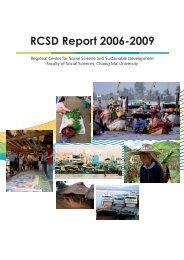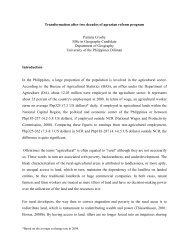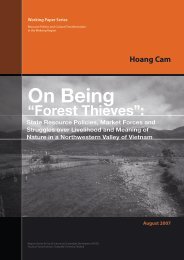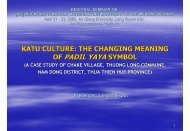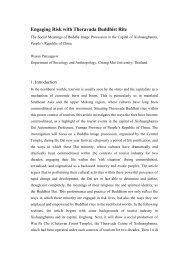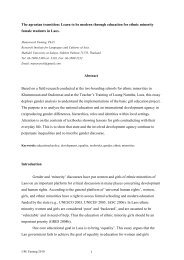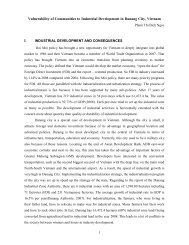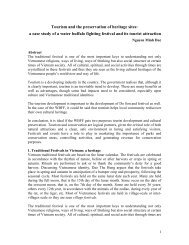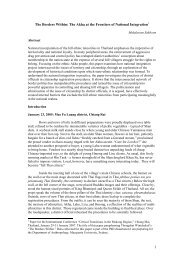The Impact of the Renovation Policies on the Livelihoods of ... - RCSD
The Impact of the Renovation Policies on the Livelihoods of ... - RCSD
The Impact of the Renovation Policies on the Livelihoods of ... - RCSD
Create successful ePaper yourself
Turn your PDF publications into a flip-book with our unique Google optimized e-Paper software.
harvesting seas<strong>on</strong>, or at <str<strong>on</strong>g>the</str<strong>on</strong>g> start <str<strong>on</strong>g>of</str<strong>on</strong>g> <str<strong>on</strong>g>the</str<strong>on</strong>g> school year or during illness. <str<strong>on</strong>g>The</str<strong>on</strong>g> interest charged byprivate sources/traders is always higher than that from government sources but private sources aremore flexible and easy to access in times <str<strong>on</strong>g>of</str<strong>on</strong>g> need.With <str<strong>on</strong>g>the</str<strong>on</strong>g> land allocati<strong>on</strong> process, <str<strong>on</strong>g>the</str<strong>on</strong>g> Government-owned Bank for Agricultural Development and<str<strong>on</strong>g>the</str<strong>on</strong>g> Bank for <str<strong>on</strong>g>the</str<strong>on</strong>g> Poor have expanded services to households for development <str<strong>on</strong>g>of</str<strong>on</strong>g> agriculturalproducts and forestry activities <strong>on</strong> household farms in <str<strong>on</strong>g>the</str<strong>on</strong>g> upland regi<strong>on</strong>. <str<strong>on</strong>g>The</str<strong>on</strong>g>se banks with manymicro-credit schemes <str<strong>on</strong>g>of</str<strong>on</strong>g>fer loans to <str<strong>on</strong>g>the</str<strong>on</strong>g> rural poor with subsidised interest rates, but poor peoplehave not been able to access <str<strong>on</strong>g>the</str<strong>on</strong>g> special credit programs. Credit groups have been established insome areas <strong>on</strong>ly and access to a loan is difficult. Bank loans are very short term and services arepoor, with c<strong>on</strong>siderable administrative paper work. Borrowers are required to put up <str<strong>on</strong>g>the</str<strong>on</strong>g>ir land orhouse as loan equity; however, most poor people cannot meet this requirement. Poor people canaccess special credit through a paper issued by commune authorities to guarantee <str<strong>on</strong>g>the</str<strong>on</strong>g>m, but localauthorities do not generally like to guarantee villagers who are too poor. <str<strong>on</strong>g>The</str<strong>on</strong>g> poorest families are<str<strong>on</strong>g>of</str<strong>on</strong>g>ten not able to access bank loans as <str<strong>on</strong>g>the</str<strong>on</strong>g>y are perceived as high risk. Most poor households stress<str<strong>on</strong>g>the</str<strong>on</strong>g> lack <str<strong>on</strong>g>of</str<strong>on</strong>g> capital to invest in multiple activities <str<strong>on</strong>g>of</str<strong>on</strong>g> agriculture and forestry.3.5.5 Extensi<strong>on</strong> servicesExtensi<strong>on</strong> can play a key role in facilitating farmers to utilise <str<strong>on</strong>g>the</str<strong>on</strong>g> full potential <str<strong>on</strong>g>of</str<strong>on</strong>g> <str<strong>on</strong>g>the</str<strong>on</strong>g>ir lands.Without any external assistance, farmers find it very hard to carry <strong>on</strong> producti<strong>on</strong> activities <strong>on</strong> <str<strong>on</strong>g>the</str<strong>on</strong>g>land. Since <str<strong>on</strong>g>the</str<strong>on</strong>g> 1990s, a network <str<strong>on</strong>g>of</str<strong>on</strong>g> extensi<strong>on</strong> in agriculture and forestry has been establishedfrom provincial level to hamlet level to support farmers during and after <str<strong>on</strong>g>the</str<strong>on</strong>g> land allocati<strong>on</strong>process. This extensi<strong>on</strong> system with a service package including techniques and services wasestablished to help farmers develop an appropriate cultivati<strong>on</strong> system and extract higher yieldproducts <strong>on</strong> <str<strong>on</strong>g>the</str<strong>on</strong>g>ir own farm. Many government reports show that <str<strong>on</strong>g>the</str<strong>on</strong>g> extensi<strong>on</strong> system hasc<strong>on</strong>tributed to successful ec<strong>on</strong>omic development in lowland and upland regi<strong>on</strong>s. However, <str<strong>on</strong>g>the</str<strong>on</strong>g>extensi<strong>on</strong> system has not reached many remote areas.In interviews, villagers in most case study areas said that <str<strong>on</strong>g>the</str<strong>on</strong>g>y did not benefit from <str<strong>on</strong>g>the</str<strong>on</strong>g>government extensi<strong>on</strong> system because no <strong>on</strong>e has visited <str<strong>on</strong>g>the</str<strong>on</strong>g>m to teach or help <str<strong>on</strong>g>the</str<strong>on</strong>g>m. Extensi<strong>on</strong>workers prefer to visit villages which are located near town centres and have good road access.<str<strong>on</strong>g>The</str<strong>on</strong>g>y do not go to remote upland villages by foot. However, <str<strong>on</strong>g>the</str<strong>on</strong>g> renovati<strong>on</strong> process givesopportunities for remote villages to receive support from internati<strong>on</strong>al d<strong>on</strong>ors.3.5.6 Support from government programs/outside projects<str<strong>on</strong>g>The</str<strong>on</strong>g> Vietnamese government has established many programs related to poverty reducti<strong>on</strong> in <str<strong>on</strong>g>the</str<strong>on</strong>g>nor<str<strong>on</strong>g>the</str<strong>on</strong>g>rn mountainous regi<strong>on</strong>. <str<strong>on</strong>g>The</str<strong>on</strong>g> objectives <str<strong>on</strong>g>of</str<strong>on</strong>g> <str<strong>on</strong>g>the</str<strong>on</strong>g>se programs are to eradicate hunger, alleviatepoverty and develop educati<strong>on</strong> and health care for <str<strong>on</strong>g>the</str<strong>on</strong>g> people. Toge<str<strong>on</strong>g>the</str<strong>on</strong>g>r with <str<strong>on</strong>g>the</str<strong>on</strong>g> governmentprograms, <str<strong>on</strong>g>the</str<strong>on</strong>g>re are many o<str<strong>on</strong>g>the</str<strong>on</strong>g>r poverty reducti<strong>on</strong> programs/projects in <str<strong>on</strong>g>the</str<strong>on</strong>g> nor<str<strong>on</strong>g>the</str<strong>on</strong>g>rn mountainousregi<strong>on</strong> funded by NGOs. For example, Vau village was supported by Program 135 forresettlement and poverty reducti<strong>on</strong>. Tea plantati<strong>on</strong> was developed here by this program o<str<strong>on</strong>g>the</str<strong>on</strong>g>rwiseVau villagers would c<strong>on</strong>tinue shifting cultivati<strong>on</strong>. Tea planting has expanded at a scale muchwider than that in <str<strong>on</strong>g>the</str<strong>on</strong>g> early 1990s. In Nac and Khuoi Ken village, a Small Grant from aDeveloping Community Forest program launched a credit scheme to provide financial assistanceto <str<strong>on</strong>g>the</str<strong>on</strong>g> villagers, which has encouraged <str<strong>on</strong>g>the</str<strong>on</strong>g> farmers to manage <str<strong>on</strong>g>the</str<strong>on</strong>g> forest as an investment since2004. Most farmers in Nac received loans from <str<strong>on</strong>g>the</str<strong>on</strong>g> credit program for investment in forestryrelated activities. Credit is available <strong>on</strong>ly for inputs (such as seedlings, seeds and nurserysupplies) procured from outside <str<strong>on</strong>g>the</str<strong>on</strong>g> farm. However, not every poor community can benefit fromPaper for Internati<strong>on</strong>al C<strong>on</strong>ference “Critical Transiti<strong>on</strong>s in <str<strong>on</strong>g>the</str<strong>on</strong>g> Mek<strong>on</strong>g Regi<strong>on</strong>”29-31 January, 2007, Chiang Mai19




